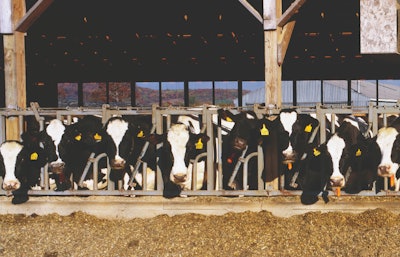
A look at the challenges the dairy industry and feed manufacturers faced in 2020, its impact on production and its embrace of cautious optimism
Despite a difficult road during the first half of the year, Rabobank forecasts a 1% YOY increase in production across the Big 7 dairy regions — the European Union, the United States, New Zealand, Australia, Brazil, Argentina and Uruguay — in the second half of 2020.
The COVID-19 pandemic dealt a series of blows to the world’s dairy and dairy feed producers, ranging from dramatic decreases in demand to ingredient shortages. However, once the markets and supply chains stabilized, the industries were granted a fresh look at the ways they could strengthen their businesses and align their feeding programs for added profitability.
The 2020 Feed Strategy Dairy Outlook report will revisit the height of the pandemic, the lessons learned and examine what producers are doing to stay ahead of market trends both from the dairyman’s and the feed manufacturer’s perspective.
Pandemic hits dairy hard
Spanning several months of H1 2020, the COVID-19 pandemic and the related lockdown response swiftly upended the demand for milk, dairy herd management and feeding strategies.
“Dairy farmers were among those that suffered most radically compared to other intensive animal industries due to a long development phase compared to monogastric producers, who can slow or accelerate production in a space of months,” says Matthew Bekker, regional technical manager – Oceania, Novus International, noting the dairy cow’s year-round cycle and the gap between gestation and reaching production age.
As the foodservice industry went offline with institutional and restaurant closures, dairy producers faced the challenge of excess inventory with nowhere for it to go and the inability for the milk delivery and logistic systems to quickly pivot to handle the surplus as the supply moved to retail sales.
 The companies featured on Rabobank’s 2020 Global Dairy Top 20 ranking saw modest turnover gains (USD), increasing by 1.3% in 2019. (Rabobank 2020)
The companies featured on Rabobank’s 2020 Global Dairy Top 20 ranking saw modest turnover gains (USD), increasing by 1.3% in 2019. (Rabobank 2020)“Dairy producers quickly reduced milk production by altering feed rations, drying off cows early and culling,” recalls Ben Laine, dairy analyst with Rabo AgriFinance. “Many producers re-evaluated their operations and stripped everything down to the essentials.”
Nutritionists were tasked with cutting “non-essential” additives and changing feed formulations to not only cut costs but also to deal with supply chain and ingredient availability issues.
“COVID-19 has challenged our supply chain for feed ingredients, from disruptions in importing ingredients to domestic supply chain issues of basic by-products that were taken for granted until now,” says Bruce Ziegler, Alltech manager of dairy nutrition and technical support for Hubbard Feeds.
“With ethanol production almost halted and packing plants shuttering to a crawl, items like DDGS (Dried Distillers Grains with Solubles) and bone meal were much harder to come by, and consequently more expensive,” says Matt Douglas, Zinpro regional business enterprise leader – North America.
The cost of feed production went up for a time, and some ingredients and finished feed shortages were driven by panic buying.
“There was an initial purchase surge for those commodities considered at-risk in global supply shortage. However, most production now continues as normal,” Bekker explains.
As a result of these disruptions, feed producers came to “the realization that supply chain balances are delicate and can be easily upset,” says Ben Towns, global business director, Arm & Hammer Animal and Food Production.
Luckily, for dairy producers in many countries, government interventions such as direct aid and dairy product purchasing programs have assisted and protected dairy producers from the impact of negative milk prices and other economic losses. However, the longevity of these programs is unknown.
The fear — and perhaps the reality of the pandemic — is that without a vaccine in 2020, with new outbreak hot spots emerging weekly and with the lack of an organized national response in some of the largest markets, the threat of a second wave and another round of lockdown measures adds substantial uncertainty to the world dairy industry.
“As dairy producers move ahead and begin to increase production once again, they will be carefully re-evaluating their feed and supplement programs, determining what is necessary and looking for opportunities to simplify,” Laine says.
Moving forward
Total global dairy feed production reached nearly 130 million metric tons in 2019, according to Alltech’s 2020 Global Feed Survey. Despite the pandemic’s influence on dairy production and rations, sources are optimistic total feed volumes will not see significant declines this year, if anything, coming out flat.
“I think dairy feed production is going to be pretty steady,” says Blaine Blackburn, vice president of sales and marketing, Westway Feed Products. “We’ve seen a bit of a shift — corn and energy sources have gotten cheaper, while molasses is at record highs — and producers have made some adjustments, which has been negative to the liquid feed business. But now corn prices are starting to creep back up, and we are seeing producers adjust their diets to bring more liquid feed in.”
However, managing feed costs and nutrition in a volatile milk market is essential for maximizing cash flow for dairy farmers, Ziegler says.
- Feed cost reductions
Experts suggest decreasing dairy feed costs and using nutrition to limit milk production will be a major focus of the industry through the remainder of the year.
“Milk production most likely will remain stagnant to prevent an ongoing price drop,” says Cecilia Lopez, product marketing manager – North America, Novus International. “Producers will struggle to make a profit and with that, nutrition will be closely monitored to determine what ingredients to use and which to reduce the use of.”
Ziegler suggests dairy producers focus on storing high-quality forages and rebuild inventories that have been challenged by wet Midwestern growing conditions the last several years to “minimize purchased feed costs, as well as to improve dairy farm cash flow with better milk production.”
“Besides the goal of harvesting high-quality forages, decisions need to be made regarding supplementation to prevent metabolic disorders, mycotoxin damage, reproductive declines and improve rumen health among other things,” Ziegler says.
Rodrigo Gardinal, Brazilian technical services manager with Novus, predicts rising raw ingredient costs, driven by exports and reduced yields due to inclement weather, will open the opportunity for producers to use more feed additives, e.g., proteases, to positively impact any alternative raw material challenges. However, in Brazil, for example, currency exchange issues will spike the cost of commodities and imported additives.
“With the increased feed costs, dairy farmers are looking to use more by-products in the feed formulations as a substitute for traditional grains and hoping to do so without suffering a decrease in animal productivity, while also trying to decrease other production costs to improve efficiency,” Gardinal explains.
In the U.S., Blackburn predicts grain prices will remain low.
“Forage quality looks to be pretty good and I would expect corn silage will be pretty strong, both in terms of quantity as well as quality unless there’s some major event that takes place in the next two months,” he says.
- Eye on components
Milk component levels directly impact farm profitability and, in turn, dairy rations.
“We need to continue to support our customers to become as profitable as possible by helping them to increase milk components, which is key to achieve additional profit for the milk that they are producing,” Lopez says.
Nutrition and feeding practices play the biggest role in milk composition, but luckily management changes can quickly alter fat and protein levels if need be.
“We’ve shifted from fat to protein, but is there a chance that we shift back towards fat?” Blackburn asks. “I think that the question is on all producers’ minds and what they’re doing from a feeding strategy to get to those components because that’s what’s going to basically keep them in business.”
- Milk price volatility and consumer demand
Laine suggests an economic recession could decrease consumer demand for milk and dairy products.
“Unemployment is likely to be one of the key factors in the current recession, and Rabobank has found that high unemployment rates negatively impact domestic dairy demand more significantly than other macro-economic factors,” he says.
Beyond bumps in cheese prices, “other classes of milk sales have not experienced price lifts and instead put many producers under financial stress,” explains Paul Krueger, vice president of animal nutrition sales, Milk Specialties Global. He feels this volatility may continue during the ever-changing COVID-19 situation and make it difficult to navigate production over the next several months.
Douglas agrees: “The last nine months have shifted the demand for dairy products drastically. With the change in consumer patterns, raw milk is needed for the processing of different products. As a result, depending on the market, the producer price differential in the U.S. has seen more variation than ever, creating great uncertainty.”
To prevent continual price decreases, Lopez feels milk production will need to be stagnant.
“The lack of demand on the foodservice side and schools being held online are directly impacting dairy products usage,” Lopez says. “Although supermarket sales have increased in demand, it is not enough to counteract these changes.”
Blackburn hopes dairy producers pay attention to these consumption trends and adjust their strategy accordingly.
“We have to examine and understand the facts for what they are and not what they used to be,” he stresses. “I think having a clear line of sight as to what has shifted in the last 12 months, a line of sight into what’s shaping the next six months and making the correct plans to adjust to those are critical for the dairyman’s success.”
Lessons learned will strengthen industry
Rabobank forecasts dairy production to increase by 0.9% YOY in the first half of 2021. Even if the world and the dairy sector return to pre-coronavirus conditions in the next several years, the dairy and feed industries should carry valuable lessons learned during the pandemic to strengthen their businesses.
- Emphasis on risk management
Risk management to mitigate the negative effects of milk price volatility is emerging as a critical on-farm management tactic for maintaining a viable dairy business, Ziegler explains.
“Risk management allows the farm to be pro-active in protecting and managing future cash flow by minimizing the effects of the milk market downturns that have taken place and will continue to take place into 2021,” he says.
- Rethinking just-in-time inventory
The food supply chain has focused on “just-in-time” delivery to enhance efficiencies, Towns notes, but the pandemic “revealed shortcomings in this approach due to choke points in the supply chain.” He believes the feed industry may shift toward keeping more raw materials and supplies in inventory to prepare for future market disruptions.
- How business is conducted
Many companies who have thrived due to in-person customer relationships have been forced to re-evaluate — and reinvent — how they do business during the pandemic. All facets of the feed industry have been forced to get creative and refine what “getting in front of the customer” means. Professionals should consider virtual communication as a permanent fixture of the next normal and seek opportunities presented by the added time and resources.
“With large, in-person meetings and trade shows being canceled, we have been able to dedicate more time to planning, customer service and strengthening our part of the supply chain to provide feed to the dairy farm,” Ziegler concludes.














